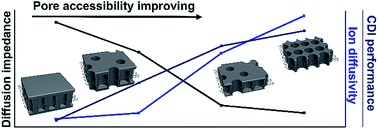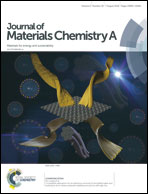Layered graphene/mesoporous carbon heterostructures with improved mesopore accessibility for high performance capacitive deionization†
Abstract
Rational design of porous carbon electrodes remains central to the development of high performance capacitive deionization (CDI) technology. Efficient electrosorption in CDI relies on the unimpeded transfer of salt ions from the bulk water to carbon pore surfaces. Improving mesopore accessibility by shortening pore lengths and opening pore apertures is expected to facilitate the ion diffusion and promote the CDI performance, however a material platform offering controls of these parameters has not been applied to CDI systems. Herein, layered heterostructures consisting of graphene sheets and conformal mesoporous carbon layers are prepared via an interfacial Stöber templating process followed by post-activation. The mesopore opening and mesopore length are simultaneously controlled to study their influences on CDI properties. It is demonstrated that the open mesopore and short mesopore length are determinant factors for high ion diffusivity and high salt adsorption capacity (SAC, 24.3 mg g−1), which illuminates new avenues to develop high performance CDI electrode materials.



 Please wait while we load your content...
Please wait while we load your content...